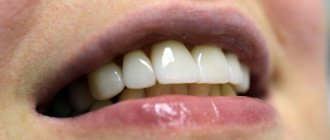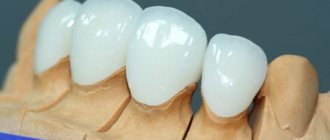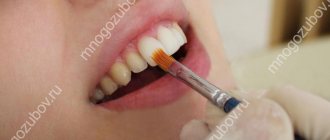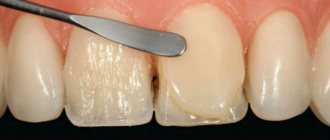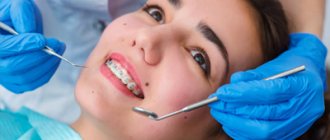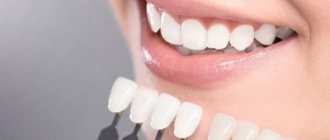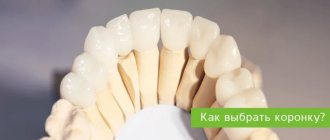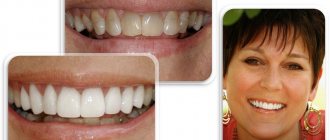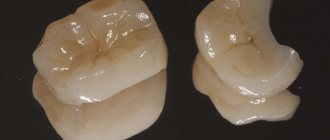To understand which veneers to choose, ceramic or composite, let’s take a closer look at what dental veneers are and what their features are. Veneers are thin plates of ceramic (sometimes zirconium) or composite material that are fixed to the front side of the teeth. Such microprostheses are used to correct aesthetic defects of the dentofacial apparatus and provide additional protection to the enamel. The onlays, made from impressions, imitate the natural shade of the dentition and do not stand out from it.
Veneering straightens the dentition, hides defects (uneven teeth, large interdental gaps, cracks or chips of the coronal shell), simplifies oral hygiene, and serves as an effective means of preventing periodontal diseases.
Author of the article: Meliksetyan Daniel Oganesovich
Work experience:
15 years
Specialization:
Dentist-orthopedist
Works:
at the clinic on Proletarskaya metro station
Composite veneers
Veneers
are microprostheses made in the form of a plate, installed on teeth to correct a cosmetic defect in one or all teeth. Allows you to correct the color and shape of natural ones. Cover the visible part of the tooth. Correct curvature, cover chips and cracks in enamel. The installation of composite veneers is carried out by a dentist, who makes them based on the structural features of the patient’s teeth.
The procedure is popular due to its excellent cosmetic effect: straight, white teeth improve your image and give you more self-confidence in everyday life. There are several types of onlays used by dentists to cover imperfections inside the mouth.
What to choose
The main advantage of composite restorations over porcelain structures is their lower price and the ability to reduce the time spent on their installation. However, this advantage can no longer be called relevant today, since technologies have appeared that make it possible to install ceramic overlays in a day.
Reviews from doctors and patients indicate that veneering eliminates dental defects, but composites are less able to imitate the natural shade and structure of the enamel. The disadvantage of composite onlays is their inaccurate fit to the tooth surface, which causes the accumulation of bacterial plaque, increasing the risk of developing caries and periodontal inflammation.
The choice of veneering type depends on the number of restorations planned, the need for additional treatment and other factors.
Composite veneers are an excellent solution for the restoration of 1-2 teeth. But if there are problems in the entire frontal area, it is better to install orthopedic ceramic overlays.
Direct composite veneers
Direct composite veneers
so called because they are installed in one visit.
They are made by the dentist in front of the patient from a composite mass, which in its composition is similar to filling material. Ideal for patients who need to correct a minor cosmetic defect. The dentist removes a thin layer from the enamel to prepare the onlays (0.3-0.7 mm), sometimes without touching the enamel at all. Several layers of material are applied to the tooth, which hardens under a lamp. At the final stage, the last layer is sanded and polished. Direct composite veneers
are convenient because the dentist makes them directly in front of the patient, adjusting them individually for each tooth. A tight fit of the plates to the surface is guaranteed.
Service life and care
Unfortunately, the service life of composite veneers is another aspect in which they are inferior to ceramic plates. Unlike the latter, which last for decades, composite overlays require renewal approximately every 4 years. In terms of care, in addition to the standard meticulous daily hygiene with a toothbrush, toothpaste, floss and irrigator, composite restorations also require periodic polishing. Therefore, you should not skip visits to the hygienist. There is no need to subject the pads to excessive mechanical stress: gnawing or biting anything with force. You can wear protective mouth guards at night to avoid accidental breakage. It is recommended to visit a doctor once every six months for a professional assessment of their condition.
Indirect composite veneers
Indirect composite veneers
are made in the laboratory by a dental technician from an impression taken from the tooth by the dentist. The overlay follows the exact shape, is selected according to color, and is sanded. Their properties are similar to composite ceramic veneers. During installation, the doctor applies slight pressure on the tooth for closer contact and a stronger connection. Suitable for installation in patients with serious problems that can be corrected with veneers. Installation is carried out on the second visit.
The plates made in the laboratory are more durable and natural compared to those made directly in the patient’s mouth.
Reviews
Sergey
Due to caries damage, a gap has formed on the front tooth. My dentist recommended putting a composite veneer on it. At first I was hesitant, but then the price tempted me. This procedure cost me 3500. The overlay has been in place for 9 years. Still intact. The only problem is that it has become dull and darkened. Now the tooth looks different.
Karena
There was a chip on the front tooth. The doctor disguised everything perfectly with a composite veneer, which lasted 6 years. When the tooth began to look very different from the rest over time, I decided to try a ceramic veneer. Now I think it’s better to immediately pay a good amount, but also get the best result.
Irina
Composite veneers are thicker in structure than ceramic veneers. Because of this, they will look unnatural from the very beginning. If such an overlay is made only on one or two teeth, then they will differ. This restoration solution is more suitable when you need to correct the entire row of front teeth.
Tatiana
I had composite onlays placed on my upper front incisors 3 years ago. So far I have no complaints. I don’t limit myself in food. I can eat a hard apple and crack the seeds. The color hasn't changed either. I believe that this method of tooth correction is the most suitable. And the price is affordable and the quality is good. Now I recommend it to all my friends.
Sources used:
- Northwestern State Medical University named after I. I. Mechnikov
- Zinovieva I.A., Zhuravleva M.G., Felker E.V. Bruxism as a pathological condition of the dental system
- Horn HR. “A new lamination, porcelain bonded to enamel.” NY St Dent J 1983
Indications for installation
The overlays restore the smile line, hiding flaws and imperfections. Indications for installation are:
- Incorrect placement of individual teeth, which can be corrected with veneers to create an even dentition.
- Darkening of natural enamel when professional whitening did not bring the desired result.
- The presence of an unaesthetic diastema.
- Unsightly, darkened fillings located on the necks of crowns.
- Tooth chip (if the loss of hard tissue was less than 60%).
- Enamel imperfections: cracks.
To whom is the technique contraindicated?
Artistic restoration of teeth with composite material is not possible for all clients, since the technique has a number of contraindications (some of them are temporary and correctable):
- Allergic reaction to the composite;
- Installed pacemaker;
- Some individual characteristics that prevent the sealing of a carious cavity;
- Poor oral hygiene;
- Night grinding of teeth (bruxism);
- Pathological bite;
- Excessive abrasion of tooth enamel;
- Frequent stay in traumatic conditions (athletes, rescuers, etc.).
By registering with Nurimed, clients can be calm about their own safety and the results of the procedure, since the clinic’s doctors individually assess the risks and benefits for everyone.
Contraindications for installation
There are contraindications for installing veneers, which the doctor will identify after examining the condition of the oral cavity. The question is not about the skill of the dentist, but about the effectiveness and expediency of the procedure. You cannot install onlays if there is a dental problem that requires monitoring or is incompatible with the concept of veneers. The dentist’s task is to honestly tell the patient about the reasons he has discovered that prevent the procedure from being performed. Contraindications for installing veneers
from any material are:
- There are erosive changes in the enamel on the surface, as well as other defects that cannot be covered with veneers due to the impossibility of observing and treating them.
- Pathological abrasion of teeth, as well as their mobility.
- Impacted tooth.
- Dental diseases of teeth and gums, especially acute conditions. 5. Incorrect bite. 6. Bruxism.
- Poor hygiene.
- Bad habits (smoking, biting off hard objects).
- Short teeth.
- Pulpless teeth without nerves.
- Imperfect bite that can be corrected with orthodontic treatment.
- Participating in extreme or active sports that pose a risk of injury.
In what cases is it relevant to use?
With the help of composite veneers, you can visually hide only minor defects. These include:
- With age, teeth change color;
- the shape of the incisor has changed (consequences of abrasion or injury);
- enamel pigmentation has occurred that cannot be whitened (pigmented cracks, fluorosis or tetracycline teeth);
- the existence of diastemas or trema;
- slight mixing of teeth in the vertical axis;
- if there is a defect in the filling, but it is stable (for example, the filling material has darkened over time);
- a composite plate can hide defects in an underdeveloped tooth that formed during its development (for example, amelogenesis or hypoplasia);
- in cases of uneven contour of the incisor neck;
Sometimes, with the help of direct composite veneers, it is possible to change the group affiliation of a tooth. An example would be the visual change from a canine to a lateral incisor.
Installation of composite veneers
- Examination of the oral cavity.
- Cleaning teeth from plaque and stones.
- Removal of caries.
- Selection of veneer shade. An important step if it is installed to close a defect on one or two teeth.
- Preparation of dental tissues before installation. Only the front surface is processed.
- For the indirect method at this stage: an impression is taken from the prepared tooth, the doctor will use it to create onlays, and the patient is fitted with temporary onlays that protect the enamel of the prepared teeth.
- Brushing teeth and applying acidic gel to treat the surface for better adhesion.
- Application of adhesive material to the front surface of the teeth.
- The onlay is attached with glue, pressed slightly and the dentist uses a lamp to harden the structure.
- Checking adhesion, removing unnecessary parts, connecting cement.
- Processing the lining, checking strength, smoothness, grinding and polishing.
Advantages of the method
Our dental center prefers composite correction for patients due to a number of its advantages:
- An ideal aesthetic result, since it is possible to select a material that completely imitates natural tooth enamel.
- Helps to correct not only external beauty, but also restore chewing function. After restoration, a person can eat any food without fear of pain or discomfort.
- The correction speed is high. One visit to the dentist is enough to restore several teeth. Especially when it comes to a modernly equipped clinic.
- Allows you to preserve the maximum amount of healthy tissue. A very gentle option for restoring a smile.
- Moderate cost of the service. Despite a number of listed advantages, the price of restoration remains affordable to every client.
How is restoration done with composites?
Stages of artistic correction in modern dental clinics:
- Removal of hard deposits and soft plaque;
- Selecting the appropriate color of the composite material;
- Local anesthesia;
- Removal of affected tissue and previously installed fillings;
- Creation of a dry working field;
- Treatment of the area with antiseptics;
- Creation of a crown by layer-by-layer application of filling material.
The last stage of correction is to adjust the crown to the specific patient. First, the shape is changed so that the patient does not feel discomfort when biting or chewing. The filling is then polished to a state identical to the enamel.
Types of procedure
The choice of dental restoration technique depends on the individual characteristics of the clinical case. The following factors are taken into account: location of defects, extent, severity. Common types of restoration:
- Veneers. Restoration of the front teeth with composite material is carried out using veneers. They also come in ceramic, but such designs are much more expensive. Application is only possible for minor damage.
- Tabs. In this way, cavities formed in deep layers are closed. The technique is gradually losing its relevance, since the strength of such a restoration is not very high.
- Fillings. The installation is carried out regardless of the complexity of the clinical case. The most common and cheapest way, thanks to which it is easy to restore aesthetic comfort.
